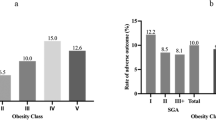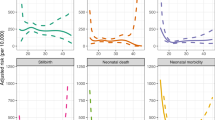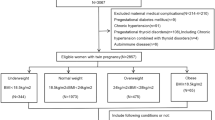Abstract
Background/Objectives
To examine the effect of pre-pregnancy maternal body mass index (BMI) on neonatal weight outcomes of twin infants who were conceived by assisted reproductive technology (ART).
Subjects/Methods
A 10-year (2006–2015) Chinese sample of 3431 mothers and their twin infants conceived by ART from a retrospective cohort were included. The effects of pre-pregnancy maternal BMI on gestational age and birth weight were assessed by generalized linear model and generalized estimating equation model.
Results
Compared with a normal weight group, pre-pregnancy maternal underweight was associated with lower birth weight and increased risk of small for gestational age (SGA) in twins conceived by ART (birth weight: difference −59.22 g, 95% CI −93.16 to −25.27 g; SGA: RR 1.25, 95% CI 1.09 to 1.43). Pre-pregnancy maternal obesity was associated with higher birth weight and increased risk of preterm birth (birth weight: difference 65.82 g, 95% CI 10.66 to 120.99 g; preterm birth: RR 1.19, 95% CI 1.03–1.37). A nonlinear relationship between pre-pregnancy maternal BMI and SGA was observed. The risk of SGA decreased with the pre-pregnancy maternal BMI up to the turning point (BMI = 21) (RR 0.90, 95% CI 0.86–0.95).
Conclusions
Among mothers undergoing ART, pre-pregnancy maternal obesity is associated with higher birth weight and higher risk of preterm birth for twin pregnancy, and pre-pregnancy maternal underweight is associated with lower birth weight and higher risk of SGA. Women preparing for ART should maintain a normal BMI to lower the chances of adverse neonatal outcomes.
This is a preview of subscription content, access via your institution
Access options
Subscribe to this journal
Receive 12 print issues and online access
$259.00 per year
only $21.58 per issue
Buy this article
- Purchase on Springer Link
- Instant access to full article PDF
Prices may be subject to local taxes which are calculated during checkout

Similar content being viewed by others
References
Crawford GE, Ledger WL. In vitro fertilisation/intracytoplasmic sperm injection beyond 2020. BJOG. 2019;126:237–43. https://doi.org/10.1111/1471-0528.15526
Van Voorhis BJ. Outcomes from assisted reproductive technology. Obstet Gynecol. 2006;107:183–200. https://doi.org/10.1097/01.AOG.0000194207.06554.5b
Wilson EE. Assisted reproductive technologies and multiple gestations. Clin Perinatol. 2005;32:315–28. https://doi.org/10.1016/j.clp.2005.03.003
Kulkarni AD, Adashi EY, Jamieson DJ, Crawford SB, Sunderam S, Kissin DM. Affordability of fertility treatments and multiple births in the United States. Paediatr Perinat Epidemiol. 2017;31:438–48. https://doi.org/10.1111/ppe.12383
Sunderam S, Kissin DM, Crawford SB, Folger SG, Boulet SL, Warner L, et al. Assisted reproductive technology surveillance - United States, 2015. MMWR Surveill Summ. 2018;67:1–28. https://doi.org/10.15585/mmwr.ss6703a1
De Geyter C, Calhaz-Jorge C, Kupka MS, Wyns C, Mocanu E, Motrenko T, et al. ART in Europe, 2014: results generated from European registries by ESHRE: The European IVF-monitoring Consortium (EIM) for the European Society of Human Reproduction and Embryology (ESHRE). Hum Reprod. 2018;33:1586–601. https://doi.org/10.1093/humrep/dey242
Meyer R, Orvieto R, Israel A, Mohr-Sasson A, Timerman Y, Gorodesky T, et al. Outcomes of singleton versus twin pregnancies in the fifth and sixth decades. Eur J Obstet Gynecol Reprod Biol. 2018;231:255–61. https://doi.org/10.1016/j.ejogrb.2018.11.007
Xi Q, Zhang Z, Wang R, Li L, Li L, Zhu H, et al. Obstetric and perinatal outcomes of intracytoplasmic sperm injection for infertile men with Y chromosome microdeletions. Medicine. 2019;98:e17407 https://doi.org/10.1097/MD.0000000000017407
NCD Risk Factor Collaboration. Worldwide trends in body-mass index, underweight, overweight, and obesity from 1975 to 2016: a pooled analysis of 2416 population-based measurement studies in 128.9 million children, adolescents, and adults. Lancet. 2017;390:2627–42. https://doi.org/10.1016/S0140-6736(17)32129-3
Chen CM. Overview of obesity in Mainland China. Obes Rev. 2008;9 Suppl 1:14–21. https://doi.org/10.1111/j.1467-789X.2007.00433.x
National Health Commission of the People’s Republic of China. 2015 Report on Chinese nutrition and chronic disease. Beijing: People’s Medical Publishing House; 2017.
Gondwe A, Ashorn P, Ashorn U, Dewey KG, Maleta K, Nkhoma M, et al. Pre-pregnancy body mass index (BMI) and maternal gestational weight gain are positively associated with birth outcomes in rural Malawi. PLoS ONE. 2018;13:e0206035 https://doi.org/10.1371/journal.pone.0206035
Chen X, Zhao D, Mao X, Xia Y, Baker PN, Zhang H. Maternal dietary patterns and pregnancy outcome. Nutrients. 2016;8. https://doi.org/10.3390/nu8060351
Houttu N, Mokkala K, Laitinen K. Overweight and obesity status in pregnant women are related to intestinal microbiota and serum metabolic and inflammatory profiles. Clin Nutr. 2018;37:1955–66. https://doi.org/10.1016/j.clnu.2017.12.013
Froylich D, Corcelles R, Daigle CR, Kirwan JP, Brethauer SA, Schauer PR. The effect of pregnancy before and/or after bariatric surgery on weight loss. Surg Obes Relat Dis. 2016;12:596–9. https://doi.org/10.1016/j.soard.2015.09.005
Kawwass JF, Kulkarni AD, Hipp HS, Crawford S, Kissin DM, Jamieson DJ. Extremities of body mass index and their association with pregnancy outcomes in women undergoing in vitro fertilization in the United States. Fertil Steril. 2016;106:1742–50. https://doi.org/10.1016/j.fertnstert.2016.08.028
McDonald SD, Han Z, Mulla S, Beyene J, Knowledge Synthesis G. Overweight and obesity in mothers and risk of preterm birth and low birth weight infants: systematic review and meta-analyses. BMJ. 2010;341:c3428 https://doi.org/10.1136/bmj.c3428
Cai J, Liu L, Zhang J, Qiu H, Jiang X, Li P, et al. Low body mass index compromises live birth rate in fresh transfer in vitro fertilization cycles: a retrospective study in a Chinese population. Fertil Steril. 2017;107:422–9 e422. https://doi.org/10.1016/j.fertnstert.2016.10.029
Singh N, Gupta P, Mittal S, Malhotra N. Correlation of body mass index with outcome of in vitro fertilization in a developing country. Arch Gynecol Obstet. 2012;285:259–63. https://doi.org/10.1007/s00404-011-2013-8
National Health Commission of the People’s Republic of China. Management and specification in maternal health care (in Chinese). China: National Health Commission of the People’s Republic of China; 2011.
Committee on Obstetric Practice, the American Institute of Ultrasound in Medicine, and the Society for Maternal-Fetal Medicine. Committee opinion No. 700 summary: methods for estimating the due date. Obstet Gynecol. 2017;129:e150–e154. https://doi.org/10.1097/AOG.0000000000002046
Sharashova EE, Anda EE, Grjibovski AM. Early pregnancy body mass index and spontaneous preterm birth in Northwest Russia: a registry-based study. BMC Pregnancy Childbirth. 2014;14:303 https://doi.org/10.1186/1471-2393-14-303
Villar J, Cheikh Ismail L, Victora CG, Ohuma EO, Bertino E, Altman DG, et al. International standards for newborn weight, length, and head circumference by gestational age and sex: the Newborn Cross-Sectional Study of the INTERGROWTH-21st project. Lancet. 2014;384:857–68. https://doi.org/10.1016/S0140-6736(14)60932-6
Zhang B, Cao Z, Zhang Y, Yao C, Xiong C, Zhang Y, et al. Birthweight percentiles for twin birth neonates by gestational age in China. Sci Rep. 2016;6:31290 https://doi.org/10.1038/srep31290
Bavdekar AR, Vaidya UV, Bhave SA, Pandit AN. Catch up growth and its determinants in low birth weight babies: a study using Z scores. Indian Pediatr. 1994;31:1483–90.
Belogolovkin V, Alio AP, Mbah AK, Clayton HB, Wathington D, Salihu HM. Patterns and success of fetal programming among women with low and extremely low pre-pregnancy BMI. Arch Gynecol Obstet. 2009;280:579–84. https://doi.org/10.1007/s00404-009-0965-8
Liu P, Xu L, Wang Y, Zhang Y, Du Y, Sun Y, et al. Association between perinatal outcomes and maternal pre-pregnancy body mass index. Obes Rev. 2016;17:1091–102. https://doi.org/10.1111/obr.12455
Salihu HM, Mbah AK, Alio AP, Clayton HB, Lynch O. Low pre-pregnancy body mass index and risk of medically indicated versus spontaneous preterm singleton birth. Eur J Obstet Gynecol Reprod Biol. 2009;144:119–23. https://doi.org/10.1016/j.ejogrb.2009.02.047
Qu P, Liu F, Zhao D, Wang Y, Wang M, Wang L, et al. A propensity-matched study of the association between pre-pregnancy maternal underweight and perinatal outcomes of singletons conceived through assisted reproductive technology. Reprod Biomed Online. 2019;39:674–84. https://doi.org/10.1016/j.rbmo.2019.06.007
Dempsey JC, Ashiny Z, Qiu CF, Miller RS, Sorensen TK, Williams MA. Maternal pre-pregnancy overweight status and obesity as risk factors for cesarean delivery. J Matern Fetal Neonatal Med. 2005;17:179–85. https://doi.org/10.1080/14767050500073456
Khatibi A, Brantsaeter AL, Sengpiel V, Kacerovsky M, Magnus P, Morken NH, et al. Prepregnancy maternal body mass index and preterm delivery. Am J Obstet Gynecol. 2012;207:212 e211–217. https://doi.org/10.1016/j.ajog.2012.06.002
Dickey RP, Xiong X, Xie Y, Gee RE, Pridjian G. Effect of maternal height and weight on risk for preterm singleton and twin births resulting from IVF in the United States, 2008-10. Am J Obstet Gynecol. 2013;209:349 e341–346. https://doi.org/10.1016/j.ajog.2013.05.052
Torloni MR, Betran AP, Horta BL, Nakamura MU, Atallah AN, Moron AF, et al. Prepregnancy BMI and the risk of gestational diabetes: a systematic review of the literature with meta-analysis. Obes Rev. 2009;10:194–203. https://doi.org/10.1111/j.1467-789X.2008.00541.x
O’Brien TE, Ray JG, Chan WS. Maternal body mass index and the risk of preeclampsia: a systematic overview. Epidemiology. 2003;14:368–74. https://doi.org/10.1097/00001648-200305000-00020
Fontana L, Eagon JC, Trujillo ME, Scherer PE, Klein S. Visceral fat adipokine secretion is associated with systemic inflammation in obese humans. Diabetes. 2007;56:1010–3. https://doi.org/10.2337/db06-1656
Romero R, Gomez R, Ghezzi F, Yoon BH, Mazor M, Edwin SS, et al. A fetal systemic inflammatory response is followed by the spontaneous onset of preterm parturition. Am J Obstet Gynecol. 1998;179:186–93. https://doi.org/10.1016/s0002-9378(98)70271-6
Wang X, Hao J, Zhang F, Li J, Kong H, Guo Y. Effects of female and male body mass indices on the treatment outcomes and neonatal birth weights associated with in vitro fertilization/intracytoplasmic sperm injection treatment in China. Fertil Steril. 2016;106:460–6. https://doi.org/10.1016/j.fertnstert.2016.04.021
Yu J, Flatley C, Greer RM, Kumar S. Birth-weight centiles and the risk of serious adverse neonatal outcomes at term. J Perinat Med. 2018;46:1048–56. https://doi.org/10.1515/jpm-2017-0176
Dowdall D, Flatley C, Kumar S. Birth weight centiles, risk of intrapartum compromise, and adverse perinatal outcomes in term infants. J Matern Fetal Neonatal Med. 2017;30:2126–32. https://doi.org/10.1080/14767058.2016.1240161
Wang AY, Safi N, Ali F, Lui K, Li Z, Umstad MP, et al. Neonatal outcomes among twins following assisted reproductive technology: an Australian population-based retrospective cohort study. BMC Pregnancy Childbirth. 2018;18:320 https://doi.org/10.1186/s12884-018-1949-0
Gaudet L, Ferraro ZM, Wen SW, Walker M. Maternal obesity and occurrence of fetal macrosomia: a systematic review and meta-analysis. Biomed Res Int. 2014;2014:640291 https://doi.org/10.1155/2014/640291
Kc K, Shakya S, Zhang H. Gestational diabetes mellitus and macrosomia: a literature review. Ann Nutr Metab. 2015;66(Suppl 2):14–20. https://doi.org/10.1159/000371628
Ogonowski J, Miazgowski T, Kuczynska M, Krzyzanowska-Swiniarska B, Celewicz Z. Pregravid body mass index as a predictor of gestational diabetes mellitus. Diabet Med. 2009;26:334–8. https://doi.org/10.1111/j.1464-5491.2009.02695.x
Soubry A, Schildkraut JM, Murtha A, Wang F, Huang Z, Bernal A, et al. Paternal obesity is associated with IGF2 hypomethylation in newborns: results from a Newborn Epigenetics Study (NEST) cohort. BMC Med. 2013;11:29 https://doi.org/10.1186/1741-7015-11-29
Han Z, Mulla S, Beyene J, Liao G, McDonald SD.Knowledge Synthesis Group Maternal underweight and the risk of preterm birth and low birth weight: a systematic review and meta-analyses. Int J Epidemiol. 2011;40:65–101. https://doi.org/10.1093/ije/dyq195.
Rahman MM, Abe SK, Kanda M, Narita S, Rahman MS, Bilano V, et al. Maternal body mass index and risk of birth and maternal health outcomes in low- and middle-income countries: a systematic review and meta-analysis. Obes Rev. 2015;16:758–70. https://doi.org/10.1111/obr.12293
Sermondade N, Huberlant S, Bourhis-Lefebvre V, Arbo E, Gallot V, Colombani M, et al. Female obesity is negatively associated with live birth rate following IVF: a systematic review and meta-analysis. Hum Reprod Update. 2019;25:439–51. https://doi.org/10.1093/humupd/dmz011
Dickey RP, Xiong X, Gee RE, Pridjian G. Effect of maternal height and weight on risk of preterm birth in singleton and twin births resulting from in vitro fertilization: a retrospective cohort study using the Society for Assisted Reproductive Technology Clinic Outcome Reporting System. Fertil Steril. 2012;97:349–54. https://doi.org/10.1016/j.fertnstert.2011.11.017
Acknowledgements
We thank the staff from Assisted Reproduction Center and Department of Obstetrics of Northwest Women’s and Children’s Hospital for their assistance with the data collection.
Funding
This research was supported by “the Fundamental Research Funds for the Central Universities” (China) (No. xzy012019116), the Key Research and Development Program of Shaanxi Province (No. 2020SF-031), and the National Natural Science Foundation of China (No. 81771657).
Author information
Authors and Affiliations
Contributions
The authors’ contributions are as follows: PQ, WS, YM, and JS conceived and designed the study; PQ drafted the manuscript; WS and JS revised the manuscript; PQ and DZ collected and cleared the data. PQ, and SD analysed the data. All authors have approved the final version of the manuscript.
Corresponding authors
Ethics declarations
Conflict of interest
The authors declare that they have no conflict of interest.
Additional information
Publisher’s note Springer Nature remains neutral with regard to jurisdictional claims in published maps and institutional affiliations.
Supplementary information
Rights and permissions
About this article
Cite this article
Qu, P., Zhao, D., Mi, Y. et al. Association between pre-pregnancy BMI and neonatal weight outcomes in twin pregnancies resulting from assisted reproductive technology: a 10-year cohort study. Eur J Clin Nutr 75, 1465–1474 (2021). https://doi.org/10.1038/s41430-021-00862-0
Received:
Revised:
Accepted:
Published:
Issue Date:
DOI: https://doi.org/10.1038/s41430-021-00862-0



